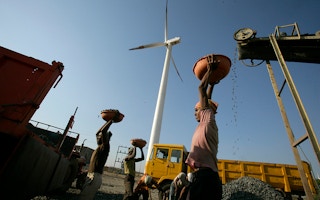You can hear—and smell—them everywhere you go in the world’s poorest countries. Diesel-burning back-up generators wail through neighborhoods at all hours, cough noxious pollutants into the air, and account for a disproportionate amount of consumers’ spending on electricity.
For decades, back-up generators have been the only real alternative to unreliable electric grids.
But what was once thought to be a temporary response to developing countries’ inadequate infrastructure has become a common feature of life in many parts of the world. Almost one billion people globally do not have access to electricity and a billion more have only intermittent service from broken grids.
As a result, many communities live almost entirely on dirty, noisy, dangerous, and expensive generators as their primary source of electricity.
The costs—to economic growth, the environment, and citizens’ health—are enormous. They are also increasingly unnecessary.
A new study by IFC, The dirty footprint of a broken grid: The impacts of fossil fuel generators, reveals for the first time the scope of the back-up generator footprint in regions with failed electric grids. The report shows the hidden costs of the global fuel-based generator fleet, and an opportunity to replace it with modern solar solutions.
The scale of generator usage is massive, and the global impact is staggering.
In the 167 developing countries studied by IFC, fuel-burning generators spread across 20 to 30 million individual sites have a total capacity of 350–500 gigawatts. That’s equivalent to 700 to 1,000 large coal-fired power plants. In western Africa alone, the electricity provided by back-up generators is equal to 40 per cent of the electricity generated by the grid.
In some countries, such as Nigeria, the installed capacity of generators is several times greater than grid capacity. One out of every five liters of diesel and gasoline in Sub-Saharan Africa is burned in a back-up generator.
To make matters worse, in developing countries, generators are often used in close proximity to the homes and businesses they serve, increasing the risk to people living and working nearby. Generators contribute to air pollution and health burdens.
The International Agency for Research on Cancer classifies exhaust from diesel engines as carcinogenic, and pollutants found in generator exhaust are associated with an increased risk of respiratory diseases. Exposure to ambient particulate-matter air pollution from generators in low and middle-income countries is already responsible for 2.5 million premature deaths annually.
Our report also reveals that each year, back-up generators emit more than 100 megatons of CO2 into the atmosphere. In Sub-Saharan Africa, the CO2 emitted from generators is equal to about 20 per cent of the total emissions from vehicles—the environmental equivalent to adding about 22 million passenger vehicles onto the road.
“
In the 167 developing countries studied by IFC, fuel-burning generators spread across 20 to 30 million individual sites have a total capacity of 350–500 gigawatts. That’s equivalent to 700 to 1,000 large coal-fired power plants.
In addition to these environmental and health hazards, generators are a massive economic burden on their users. The annual spending on diesel and gas for generators is up to USD$50 billion, with an average service cost of USD$0.30 per kwh for fuel alone, approximately double the average cost of grid electricity.
In markets with the highest generator use, including much of Sub-Saharan Africa, more money is spent on fuel for generators than on the entire power grid.
It doesn’t have to be this way.
With rapid improvement in efficiency, performance, and pricing, today’s advanced solar and battery storage solutions offer a superior alternative.
It’s time to adopt these game-changing technologies on a global scale.
This is an opportunity for the private sector to catalyse new markets for modern energy access—and vastly improve economic conditions in parts of the world still tethered to broken electrical grids.
IFC worked with industry pioneers to build today’s USD$1 billion market for off-grid solar technologies, which have broadly displaced the stop-gap reliance on kerosene lighting. Now we’re working in partnership with the governments of Italy and the Netherlands, the IKEA Foundation, and the private sector, to quickly grow the industry’s transformative response to this opportunity.
We believe a revolution is possible in the next few years by working with first-mover companies to develop products and business models that can replace privately operated back-up generators at scale.
This is both a moral imperative and a significant market opportunity. We must marshal resources and work with the private sector to accelerate development. Together, we can offer a clean solution to a dirty problem.
Philippe Le Houérou is chief executive of International Finance Corporation (IFC). This story was published with permission from Thomson Reuters Foundation, the charitable arm of Thomson Reuters, that covers humanitarian news, climate change, resilience, women’s rights, trafficking and property rights. Visit http://news.trust.org/climate.











